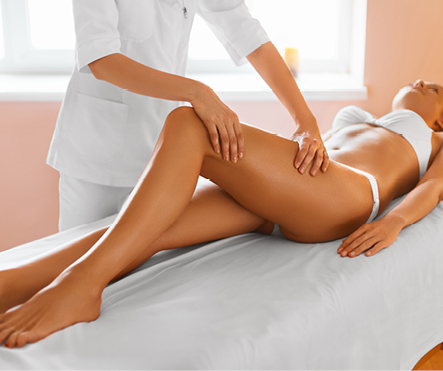
LYMPHATIC DRAINAGE IN MARBELLA
What is lymphatic drainage?
Manual lymphatic drainage is a massage therapy technique that consists of applying gentle massages to different areas of the body with the aim of improving the circulation of lymph and the lymphatic system. The function of this technique is to improve the automatic contraction of the lymphatic vessels, helping to eliminate oedemas and other alterations derived from poor lymph circulation.
The lymphatic system is responsible for transporting the waste products derived from the nutrition of the cells to the blood, which then carries them to the excretory system for elimination. Oedemas appear when the lymphatic system cannot purify certain areas, so liquids and substances stagnate. The pressure applied during lymphatic drainage helps to draw the retained fluids into the circulatory system and the blood. In addition to transporting waste substances from cells, the lymphatic system also acts as the body's defence system: this is due to the lymph nodes, structures that are located in various areas of the system and which act by purifying pathogens and neutralising the damage they can cause.
Fluid accumulation in the tissues may be due to several causes, such as a malfunction of the lymphatic system itself, natural or induced (the latter usually due to lymph node removal, which is common in the surgical treatment of certain tumours). Fluids can also accumulate for reasons that have nothing to do with lymph, as in the case of venous oedema, lipoedema, traumatic oedema, oedema during pregnancy, liver cirrhosis, malnutrition, etcetera.
What is manual lymphatic drainage?
The massage applied in lymphatic drainage must follow a series of specific guidelines that allow it to fulfil its function:
- It has to be a very gentle and painless massage, so it usually has a pleasant and relaxing effect.
- The hands should make a slow, repetitive movement that should follow, to some extent, the direction of the lymphatic ducts.
- Lymphatic drainage usually takes no less than an hour.
Health benefits of manual lymphatic drainage
Lymphatic drainage is increasingly used in oncology for the treatment of traumatic oedema, lymphoedema and lymphatic complications following surgery. It is also often used for aesthetic purposes. The benefits of this technique are:
- It reactivates lymphatic circulation and helps to eliminate excess fluids and waste substances from the body.
- Reduces swelling due to fluid retention, regulating muscle tone.
- It helps to improve the body's defences by supporting the function of the lymph nodes.
- It improves the appearance of the skin and combats diseases and conditions such as cellulite and acne.
- It has an analgesic effect, so it is also recommended for pain resulting from diseases such as fibromyalgia.
- It has a relaxing effect on the nervous system, relieving stress and anxiety, but also combating the effects of pathologies such as migraines and vertigo.
- It improves blood circulation (the lymphatic system complements the circulatory system) and helps to eliminate problems caused by poor circulation, such as varicose veins.
- Stimulates kidney function.
Contraindications to manual lymphatic drainage
Although lymphatic drainage has numerous benefits for the body, in some circumstances it is not recommended due to the effects it can produce. The main contraindications are in the following cases:
- Acute infections: Improving lymph circulation can help the infection to spread through the body.
- Phlebitis and thrombosis.
- Cardiac insufficiency: Lymphatic drainage requires a greater cardiac effort, which is not recommended when suffering from cardiac insufficiency.
- Hypotension: After a lymphatic drainage session, blood pressure drops, so it is not recommended to undergo this therapy in cases of hypotension.
- Acute inflammations, hyperthyroidism, asthma and acute asthmatic bronchitis.
Call us for an appointment... and start feeling better tomorrow!